Regions
Texel Mountains, Western Pfunderer Mountains, Eastern Pfunderer Mountains, Durreck Range, Western Rieserferner Mountains, Val Müstair Alps, Western Deferegger Alps, Langtaufers, Schnals Ridge, Southern Stubai Alps, Southern Zillertal Alps and High Tauern, Saldurn-Mastaun Ridge
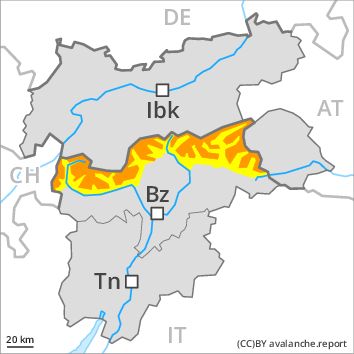
Danger level
Danger Level 3 - Considerable above the treeline
Danger Level 2 - Moderate above the treeline
Avalanche Problem
Wind-drifted snow above the treeline, N-NE-E-SE-S-SW-W-NW

The conditions are sometimes critical for backcountry touring and other off-piste activities.
As a consequence of a moderate wind, further wind slabs will form. They are in some cases prone to triggering. They can be released even by a single winter sport participant in all aspects. This applies in particular at their margins. Mostly the avalanches are medium-sized. In regions with a lot of snow avalanche prone locations are more prevalent and the danger is greater.
Avalanches can also penetrate deep layers and reach dangerously large size. The avalanche situation is a little more favourable in highly frequented off-piste terrain.
Snowpack
dp 6: cold, loose snow and wind
In some cases the various wind slabs have bonded still only poorly with each other and the old snowpack. Faceted weak layers exist in the old snowpack. The old snowpack will be in some cases prone to triggering. Distinct weak layers in the lower part of the snowpack can be released in some places.
Tendency
Hardly any decrease in avalanche danger.
Regions
Gröden Dolomites, Prags Dolomites, Sarntal Alps, Sexten Dolomites, Ortler Range, Ulten Valley, Eastern Nonsberger Alps, Northern Dolomites of Fiemme
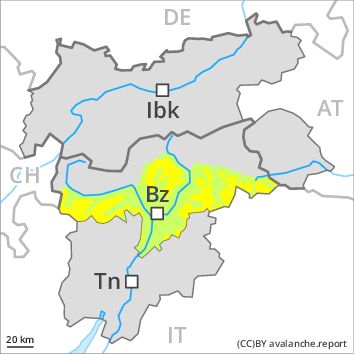
Danger level
Danger Level 2 - Moderate above the treeline
Danger Level 1 - Low above the treeline
Avalanche Problem
Wind-drifted snow above the treeline, N-NE-E-SE-S-SW-W-NW

Fresh wind slabs require caution.
As a consequence of fresh snow and a strong wind, further wind slabs will form over a wide area. The wind slabs are in isolated cases prone to triggering. The avalanche prone locations are to be found in all aspects, especially in gullies and bowls, and behind abrupt changes in the terrain. Avalanches can be released in the weakly bonded old snow also. In steep terrain there is a danger of falling on the hard snow surface.
Snowpack
dp 6: cold, loose snow and wind
In some regions up to 5 cm of snow, and even more in some localities, will fall. In some places fresh snow and wind slabs are lying on soft layers. The snowpack will be subject to considerable local variations. Individual weak layers exist deep in the snowpack on shady slopes.
Tendency
Hardly any increase in avalanche danger.
Regions
Weißkugel Range, Western Verwall Mountains, Gurgler Range, Central Stubai Alps, Eastern Verwall Mountains, Northern Zillertal Alps, Allgäu Alps, Silvretta, Venediger Range, Samnaun Mountains, Eastern Lechtal Alps - Ammergau Alps, Northern Oetz and Stubai Alps, Mieming Mountains, Eastern Rieserferner Mountains, Western Tuxer Alps, Karwendel Mountains, Glockner Range, Eastern Tuxer Alps, Western Lechtal Alps, Central Lechtal Alps, Glockturm Range, Grieskogel Mountains

Danger level
Danger Level 2 - Moderate above the treeline
Danger Level 1 - Low above the treeline
Avalanche Problem
Wind-drifted snow above the treeline, N-NE-E-NW

Fresh wind slabs require caution.
As a consequence of fresh snow and a strong southwesterly wind, sometimes easily released wind slabs will form above the tree line. They can be released even by a single winter sport participant. The avalanche prone locations are to be found in particular adjacent to ridgelines and in gullies and bowls in northwest to north to east facing aspects. The sometimes fresh snow-covered wind slabs of the last two days can be released in isolated cases. At elevated altitudes the avalanche prone locations are more prevalent.
Weak layers in the old snowpack can still be released in very isolated cases in particular in little used backcountry terrain, especially above approximately 2300 m at transitions from a shallow to a deep snowpack. The avalanche prone locations are very rare but are difficult to recognise.
Snowpack
dp 6: cold, loose snow and wind
The snowpack will be subject to considerable local variations. The wind slabs of the last two days have settled a little in all aspects. In some regions up to 10 cm of snow, but less in some localities, will fall. The strong wind will transport the fresh snow. As the day progresses brittle wind slabs will form in particular in the regions exposed to heavier precipitation.
Faceted weak layers exist deeper in the old snowpack in particular on little-used, rather lightly snow-covered shady slopes. This applies in particular above approximately 2300 m.
Tendency
Hardly any decrease in avalanche danger.
Regions
Southern Adamello, Primiero - Pale di S. Martino, Cembra Valley, Western Nonsberg Alps, Southern Brenta, Fassa Valley, Southern Lagorai, Northern Lagorai, Latemar, Paganella, Pine' - Mocheni Valley
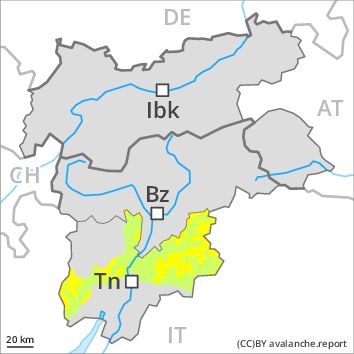
Danger level
Danger Level 2 - Moderate above the treeline
Danger Level 1 - Low above the treeline
Avalanche Problem
Wind-drifted snow above the treeline, N-NE-E-SE-S-SW-W-NW

In some localities increase in avalanche danger as a consequence of the fresh snow.
As a consequence of fresh snow and a strong wind, wind slabs formed in some places. Fresh wind slabs are mostly shallow but prone to triggering. The avalanche prone locations are to be found in all aspects, especially in gullies and bowls, and behind abrupt changes in the terrain. Avalanches can be released in the old snowpack especially at transitions from a shallow to a deep snowpack. The avalanche prone locations are barely recognisable because of the poor visibility. In steep terrain there is a danger of falling on the hard snow surface.
Snowpack
dp 6: cold, loose snow and wind
Little snow has fallen. The fresh and somewhat older wind slabs are mostly small and can only be released in isolated cases. In some cases relatively hard layers of snow are lying on old snow containing large grains. Individual weak layers exist deep in the snowpack on shady slopes. The snowpack will be subject to considerable local variations. The surface of the snowpack will freeze to form a strong crust and will soften during the day. Below approximately 2000 m only a little snow is lying on south and southwest facing slopes.
Tendency
Increase in avalanche danger as a consequence of the fresh snow.
Regions
Brandenberg Alps, Western Kitzbühel Alps, Wilder Kaiser Mountains - Waidring Alps, Eastern Kitzbühel Alps

Danger level
Danger Level 2 - Moderate above the treeline
Danger Level 1 - Low above the treeline
Avalanche Problem
Wind-drifted snow above the treeline, N-NE-E-NW

Fresh wind slabs require caution.
As a consequence of fresh snow and a strong southwesterly wind, sometimes easily released wind slabs will form above the tree line. They can be released even by a single winter sport participant. The avalanche prone locations are to be found in particular adjacent to ridgelines and in gullies and bowls in northwest to north to east facing aspects. The sometimes fresh snow-covered wind slabs of the last two days can be released in isolated cases. At elevated altitudes the avalanche prone locations are more prevalent.
Snowpack
dp 6: cold, loose snow and wind
The snowpack will be subject to considerable local variations. The wind slabs of the last two days have settled a little in all aspects. In some regions up to 10 cm of snow, but less in some localities, will fall. The strong wind will transport the fresh snow. As the day progresses brittle wind slabs will form in particular in the regions exposed to heavier precipitation.
Tendency
Hardly any decrease in avalanche danger.
Regions
Eastern Deferegger Alps, Schober Mountains, Lienzer Dolomites
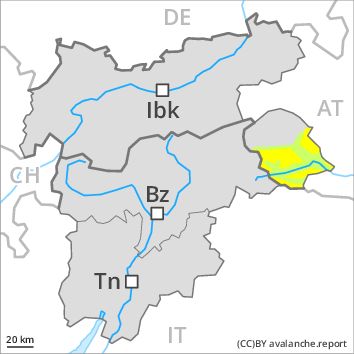
Danger level
Danger Level 2 - Moderate above the treeline
Danger Level 1 - Low above the treeline
Avalanche Problem
Wind-drifted snow above the treeline, N-NE-E-NW

Fresh wind slabs require caution.
As a consequence of fresh snow and a strong southwesterly wind, sometimes easily released wind slabs will form above the tree line. They can be released even by a single winter sport participant. The avalanche prone locations are to be found in particular adjacent to ridgelines and in gullies and bowls in northwest to north to east facing aspects. At elevated altitudes the avalanche prone locations are more prevalent.
The fresh snow and wind slabs are lying on a crust at elevated altitudes. There is a danger of falling on the icy crust.
Snowpack
dp 6: cold, loose snow and wind
The snowpack will be subject to considerable local variations. In some regions up to 10 cm of snow, but less in some localities, will fall. The strong wind will transport the fresh snow. As the day progresses brittle wind slabs will form in particular in the regions exposed to heavier precipitation. The old snowpack will be generally stable.
Tendency
Hardly any decrease in avalanche danger.
Regions
Adamello - Presanella, Northern Brenta - Peller, Sole, Pejo and Rabbi, Maddalene

Danger level
Danger Level 2 - Moderate above the treeline
Danger Level 1 - Low above the treeline
Avalanche Problem
Wind-drifted snow, N-NE-E-SE-S-SW-W-NW

In some localities increase in avalanche danger as a consequence of the fresh snow.
As a consequence of fresh snow and a strong wind, wind slabs formed in some places. Fresh wind slabs are mostly shallow but prone to triggering. The avalanche prone locations are to be found in all aspects, especially in gullies and bowls, and behind abrupt changes in the terrain. Avalanches can be released in the old snowpack especially at transitions from a shallow to a deep snowpack. The avalanche prone locations are barely recognisable because of the poor visibility. In steep terrain there is a danger of falling on the hard snow surface.
Snowpack
dp 6: cold, loose snow and wind
In some localities up to 5 cm of snow. fell. Over a wide area fresh snow and wind slabs are lying on a hard crust. The snowpack will be subject to considerable local variations. Individual weak layers exist deep in the snowpack on shady slopes.
Tendency
Increase in avalanche danger as a consequence of the fresh snow.
Regions
Prealps, Bondone and Stivo, Vallarsa, Folgaria - Laverone, Ledro Valley, Marzola - Valsugana
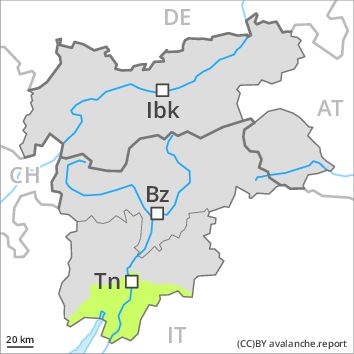
Danger level
Danger Level 1 - Low

In some localities increase in avalanche danger as a consequence of the fresh snow.
The sometimes strong wind has transported only a little snow. The no longer entirely fresh wind slabs have bonded quite well with the old snowpack. These can only be released by large loads in most cases. The avalanche prone locations are to be found in particular on steep northwest to north to southeast facing slopes above approximately 1800 m, especially in gullies and bowls, and behind abrupt changes in the terrain. These places are clearly recognisable to the trained eye.
In steep terrain there is a danger of falling on the icy crust.
Snowpack
The somewhat older wind slabs are mostly small and can only be released in isolated cases. Over a wide area relatively hard layers of snow are lying on old snow containing large grains. Individual weak layers exist deep in the snowpack on shady slopes. The snowpack will be subject to considerable local variations. The surface of the snowpack will freeze to form a strong crust and will soften during the day. On south and southwest facing slopes a little snow is lying in all altitude zones.
Tendency
Increase in avalanche danger as a consequence of the fresh snow.








